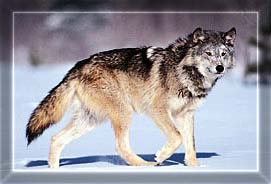|
|
|
Wolves
![]()
The Wolf is either one of two species of
wild doglike carnivores of
the family Canidae. The
gray, or timber, wolf (Canis lupus) is the best-known species.
It is the largest
wild member of the dog family and still inhabits large areas in the
Northern Hemisphere.
The red wolf (Canis rufus) is somewhat smaller and occupies a
much more restricted range.
The gray wolf has a larger natural distribution than any other mammal except human
beings. It formerly inhabited all of North America from Alaska and Arctic Canada
south to central Mexico and was found throughout Europe and Asia southward to
the Mediterranean Sea, the Arabian Peninsula, and parts of India and China. It
lived in every type of habitat in the Northern Hemisphere except tropical forests
and arid deserts. The gray wolf has been exterminated from much of its original
range, however, and its numbers are dwindling in many areas. In North America
it is now found primarily in Canada and Alaska, with much smaller numbers in Minnesota
and Mexico. In 1995 wolves were reintroduced in wilderness areas of the northern
Rocky Mountains. Large numbers of gray wolves still live in Russia and neighbouring
countries and in the Balkans, with much smaller populations isolated in parts
of central and southern Europe and Scandinavia.
The gray wolf is a powerful animal with a broad head, robust limbs, large feet,
and deep but narrow chest. Excluding certain domestic breeds of dogs, it is the
largest living canid. A northern male may be about 2 m (6.5 feet) long, including
the bushy, 50-centimetre (20-inch) tail, and weighs 20 to 80 kg (44 to 175 pounds).
Females are slightly smaller than males, and southern races of wolves tend to
be smaller than northern ones. The fur of the gray wolf is dense, long, and soft.
The fur on the upper body, though usually gray, may be brown, reddish, black,
or whitish, while the underparts and legs are usually yellow-white.
An intelligent, social animal that was admired by the American Indians, the gray
wolf usually lives in packs of several to two dozen individuals. A pack is basically
a family group consisting of an adult pair and their offspring of various ages.
There is a clearly defined dominance hierarchy in the pack, with only the lead
male and female (the alpha pair) possessing the right to mate. They are usually
the parents of the other pack members. A pack's home range, or territory, typically
amounts to one hundred or several hundred square kilometers and is actively defended
against neighboring packs. The group howling that wolves engage in serves to
solidify a pack's social structure and signal its presence to other packs.
Wolves move and hunt mostly at night. A wolf pack feeds primarily on large herbivores
such as deer, moose, and caribou, which it catches by a stalk and a chase. The
pack gorges when food is available, usually reducing the carcass to hair and a
few bones. In its hunting the gray wolf performs an important natural function
in controlling the numbers of large herbivores and in weeding out those less fit
for survival. Unfortunately, it may attack domestic livestock and has thus undergone
persecution by humans. There have been none, if any, substantiated wolf attacks
on humans in North America.
Gray wolves breed between January and April, and a litter of 6 to 7 pups (on average)
is born in the spring after a gestation period of about 63 days. The young are
reared in a den consisting of a natural hole or a burrow, usually in a hillside.
All the members of a pack care solicitously for the young, who are fed with meat
regurgitated by their parents after a hunt. Juveniles remain with the pack until
they reach sexual maturity at less than two years, after which they leave to search
for a mate and establish new territories.
The red wolf (C. rufus) is a tawny, reddish, or black canid of the south-central
United States. It grows to a length of about 105-125 cm, excluding the tail, which
is 33-43 cm long, and weighs about 14-37 kg. It is an endangered species; the
total population in the late 20th century appeared to be fewer than 100.
The largest known wolf, the dire wolf (C. dirus), was common in western
North
America during the Pleistocene but is now extinct; it was half again as large
as the modern gray wolf.
The coyote, a North American canid, is sometimes called prairie, brush,
or little, wolf.
Other animals known as wolves but not of the genus Canis, are maned wolf,
aardwolf, and Tasmanian wolf.
The Antarctic wolf, now extinct, was a South American fox of the Falkland
Islands.

Links:
Wolves' Domain
![]()
Foxes
|| Loons || Manatee
Moose || Raven || Turkey
|| Wolves
Main SiteGuide
Avian Critter || Canine Critter
|| Human Critters
Beanie
Critters || Wild Critters
Interests & Hobbies & Links, Oh My!
![]()
graphics/design by me: Papagei Studios